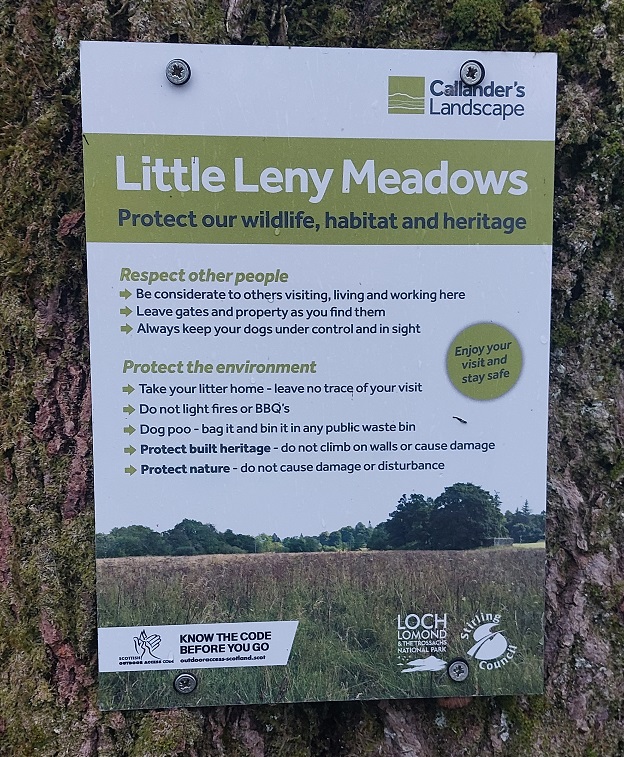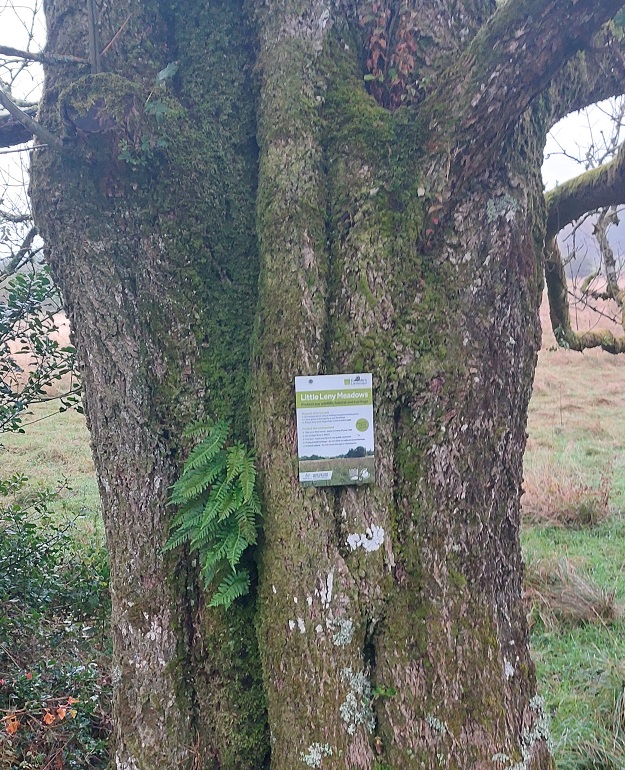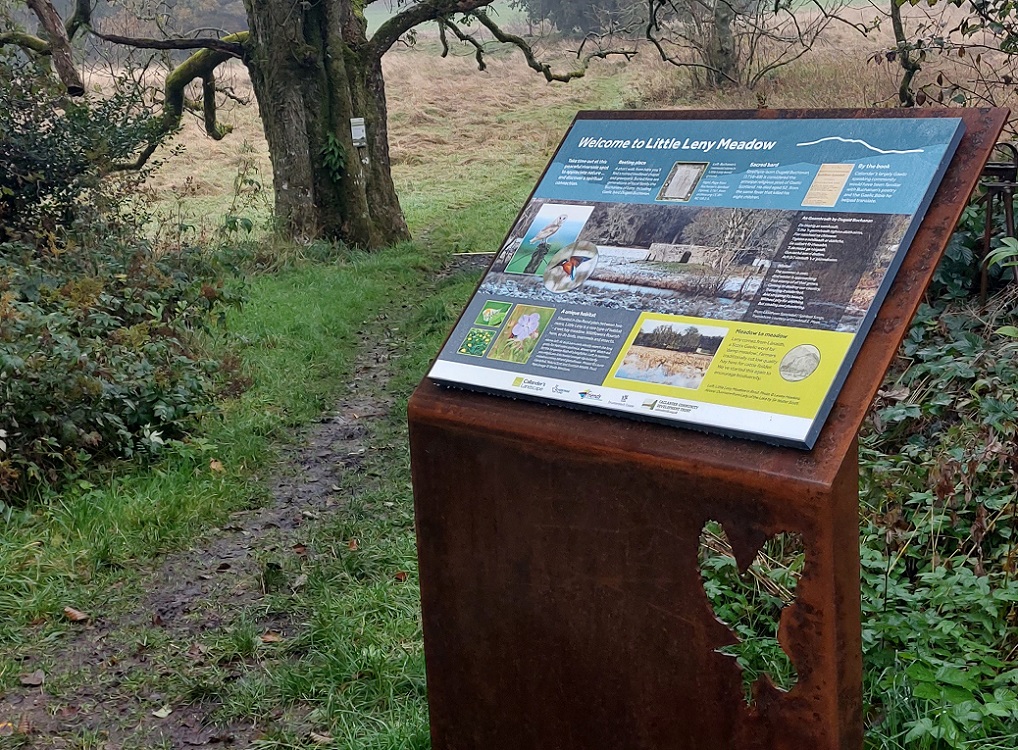 What message does this sign, exhorting people “to protect our wildlife, habitat and heritage”, give when it has been screwed into an ancient oak tree?
What message does this sign, exhorting people “to protect our wildlife, habitat and heritage”, give when it has been screwed into an ancient oak tree?

With all sorts of creatures boring holes into oaks four shiny screws may not spell the end for this tree, though it will for the mosses and lichens behind it. The official signage guidance for outdoor access produced in 2009, however, could not be clearer (see here – page 34):
“Never fix signs to living trees – this is damaging to the tree”.
“In some situations, particularly in rural environments, it is desirable to avoid signs that are intrusive or out of character”
This provides yet another example of the Loch Lomond and Trossachs National Park Authority (LLTNPA) lecturing the public about about the need to respect the natural environment while failing to do itself, just like telling the public not to drop litter while itself planting trees in plastic tubes (see here). Screwing signs to old trees is stupid, arrogant – one law for us, another for the public – and damages the reputation of our National Parks.
Why should anyone observe guidance, purportedly issued under the Scottish Outdoor Access Code, which is screwed into an old oak tree?
The wording on the Leny Meadows sign and the Scottish Outdoor Access Code (SOAC)
After the creation of new rights of access under the Land Reform (Scotland) Act 2003 a great deal of effort, involving all interests, was spent on getting the wording of the Scottish Outdoor Access Code (see here) right before it was approved by the Scottish Parliament. For the first eight or so years, this worked well but then various people, including some working for access authorities, decided that they knew better and started agitating for more controls over how the public exercised their access rights. In 2014, however, the Land Reform Review Group (see here), rejected those claims and concluded the SOAC was fit for purpose.
The SOAC is based on three key principles, all of which have been modified on the sign:
- “Respect the interests of other people” has been shortened to “respect other people“. The meaning of the two is not the same. It is the “interests” that is the important bit. Why should anyone respect land-managers who shout unreasonable and abusive instructions at the public – it has been known to happen! – or people on bikes who come tearing down narrow paths without warning? That doesn’t mean their interests should be disregarded. Rude land-managers still have a right to pursue legitimate land management operations without undue interference. What matters – and how consensus about the management of access rights is reached – concerns the interests of the different parties. The SOAC was designed to get people to think about how their interests might interact and affect the interests of others, something far more profound than the exhortation to “respect other people”.
- The second principle, “care for the environment“, which is quite positive in tone has become “protect the environment” which is more negative in tone: it betrays a standpoint where people exercising access rights are primarily seen as being a problem for the natural environment rather than this being the best means to make people appreciate the value of nature.
- The third principle, “take responsibility for your own actions“, is about people taking care for their own safety and the safety of others. This has been reduced to the meaningless exhortation on the sign that now accompanies so much of government policy in Scotland, “stay safe”.
The messages below the headings are more of a mixed bag as far as SOAC is concerned. The two bullet points about dogs are exemplary. The advice to keep them under control reflects the wording of SOAC, unlike the signs that claim all dogs should be kept on a lead at all times, while the message to bin dog poo is positive, advising dog-owners what to do with it rather than saying “don’t”.
Unfortunately, under the “Protect the Environment” heading there are three further bullet points which say “don’t”, reinforcing the negative headline “protect”. They are contrary to Signage Guidance for Outdoor Access which states “Make messages positive and informative”.
“Do not light fires or BBQs” also specifically contradicts SOAC: if there are good reasons that people shouldn’t haven’t barbeques on Leny Meadows, these should be stated and alternative places suggested. Meantime other two messages, “do not climb on walls” and “do not damage or cause disturbance [to nature]” also contradict the guidance on signage which states:
“Avoid lists of do’s and do nots – it may not be Code compliant and some people do not like being told what they can or cannot do and so may simply ignore the sign. Try to explain the reasons why people are being asked to behave in a certain way”
No-one passing this sign on the old oak tree would have any idea of how they might alter what they do to avoid “disturbing nature”. One wonders if the LLTNPA is clear what they want people to do and why either?
The LLTNPA needs to stop shooting itself in the foot on access rights

The pity is the oak tree sign has been erected a short distance beyond an excellent interpretation board that has been erected as part of the Callander Landscape Project (see here) funded by a £1.43m grant from the Heritage Lottery Fund. The interpretation board is both positive, “Welcome to Little Leny Meadow”, and contains interesting information about the burial ground and meadow. At a time when the LLTNPA has retreated from erecting interpretation boards as part of cost-saving it is good to see the Callander Landscape Partnership doing this.
But, having got one sign right, it is as if the LLTNPA could not quite trust itself so had to go and erect another sign with do’s and don’ts just beyond! And, not only that, but on an old oak tree! This undermines the Callander Landscape Partnership’s professed aim to “transform the Callander area into the outdoor capital of the National Park”.
One wonders if the LLTNPA’s Local Access Forum (LAF), which has been excluded from far too much of the Park’s access work (see here), was asked for its advice? According to the guidance on signage “Local Access Forums should be involved in the development of a signage strategy
or local signage plan”.
And what about the LLTNPA’s former Litter Manager, a post that has now been become a “Behaviour Change Manager”, was she asked what impact this sign would have on the behaviour of the public?
While signs such as that on the old oak tree would be better just avoided, there are lots more opportunities in the Callander area for for good interpretation boards, not least because of its fantastic geology and glacial landforms. Most people pass these without appreciating what they are seeing. Callander could have been the geological capital of the National Park but unfortunately significant parts of that earth heritage, as I will consider in a future post, are being lost due to planning decisions. The Callander Landscape Partnership could be an opportunity to rectify some of that but if they are to do so they need to get their signage on access right.
Update 30th November
Today I received the following from the LLTNPA Access Team:
“After some lengthy enquiries it has transpired that the sign was erected by the local wildlife group. Our contacts at the Callandar Landscape Partnership have offered to liaise with the group to have the sign moved to a more appropriate location”.
Clearly responsibility for the sign did not lie with the Access Team and it is great to see them taking appropriate and rapid action. Well done them!

The proliferation of signs and “interpretation boards” is a modern plague. Often used to push an agenda, they are quite unnecessary in a world where everyone carries a device giving them access to all the information they could want.
Typically they will not be maintained so in a very short time they will be faded and illegible rotting eyesores providing an ideal platform for grafitti and vandalism. The cost of buying and installing these things is astonishing in the context where paths and access cannot be maintained “because there’s no money” and access departments have been defunded.
There is a classic example in the forest at Tobermory where a shiny new board encourages visitors to use a lookout tower which turns out to be blocked off because it is falling apart from neglect. Others direct you to the public toilets which turn out to be closed and locked for unspecified reasons.
lol Tell me about it. That’s ringing all sorts of bells. At the NP Fish and Fisheries Forum the Callander Mob were never done going on about the urban “riff raff.” They were looking for “reinforcements” to man the barricades. A “Welcoming Committee.” Roger Bradley(deceased) and Mike Luti. Dad’s Army wasn’t in it. But that wasn’t the worst. I was on the All Abilities Sub-Group for disabled access. Well it was criminal what went on there. It wasn’t my fault but I’m still ashamed of it. I invited John Hood of the Wheelyboat Trust to join us. He’s disabled and he had to drive over from the East Coast. I’d already got a Wheelyboat for the Carman Reservoir with one of the locals so I knew what was what. I’d already written all over The Loch to see if there was any interest. None. Not one single response. So, me and Roger and John got together and prepared everything for the NP in fine detail. By this time the Wheelyboats were all inclusive, not just for disabled anglers. We met with the NP’s lady Access Officer. I’ve forgot her name. She didn’t give a hoot and went on about how it all had to be “demand led.” John was furious. Disabled people have enough on their plates without jumping through hoops for these people. I don’t know if they ever did get a Wheelyboat for Loch Lomond. They had one on the Lake of Menteith. They were on the FFF. Big Quint.